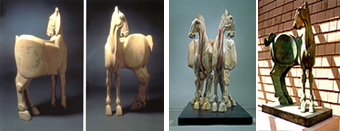
Jözef Sumichrast has managed and balanced professional transition, commercial success and artistic integrity in a uniquely satisfying way. His visual work is full of patterns, which lead to careful breaks in the pattern.
His career at the drawing board started with architectural drafting in high school. He attended the American Academy of Art in Chicago, then worked in a series of commercial art studios. He recalls going through an Andy Warhol and "Yellow Submarine" phase, but recently described those late-'60s influences as both "exciting" and "useless."
He ventured out as a freelancer in 1974, and, thanks in part to his years with the studios, which gave him what he calls "a good business sense," he has consistently hovered at the top of his profession. His brilliant commercial success has included huge amounts of advertising work, as well as children's books, board games and alphabets.
Much of Sumichrast's artistic success and fame have resulted from his ability to force things into shapes: his distinctive pictorial alphabets, which blend the fantastic and the mundane, the careful and the grotesque. Grounded in crisp realism, they burst into strident exaggeration. For example, he renders the details of feathers, a monkey's fingers, or a pleat in a skirt with sharp accuracy, but an elephant's trunk is the same size as its leg, and Groucho Marx "L" smokes a cigar the size of a loaf of bread.
The alphabets fall under one of Sumichrast's predilections, what has been described as "a sequence of imagery that expresses a unified theme." Always, in these sequences, the images seem to be bursting at the seams. As a logical progression, Sumichrast is now moving beyond this volume-packed two-dimensional world into a third dimension. In 1990, he began transforming images from his alphabets into clay models and casting them in bronze.
An "S" has become a sculpture of a muscular mermaid, which in the original was holding books, with a trio of vivid fish at the bend in her tail. She has lost her books and her scales, and her eyes look more playfully back over her shoulder instead of ahead and upward. The swell of her thigh and belly, so apparent from the front, disappears from the side, where she is silvery, sinewy and shockingly flat.
All of these drawings and concepts show the humor and accessibility of Sumichrast's work, the bright, child-like quality that makes his drawings so attractive. His rich menagerie of figures, with their bold coloring and strong shading, their confident exaggeration, seem readily identifiable. But the artist's nature is more elusive.
Consider the cover of the May/June '92 issue of Print, on which Sumichrast has depicted the artist as an unshaven question mark in a suit and tie (yellow and green, matching the yellow walls and green furniture), hovering between an empty file cabinet and a drafting table (with a blank sheet of paper taped to it). The artist's shadow on a bare wood floor makes the dot at the bottom of the question mark. His eyes are closed, his hands shoved in his pockets. The picture raises questions. Is the artist tired or dreaming? Does the blank paper represent opportunity or frustration? "What next?" it seems to ask.
Sumichrast's career promises surprising answers.
- Derek Nelson